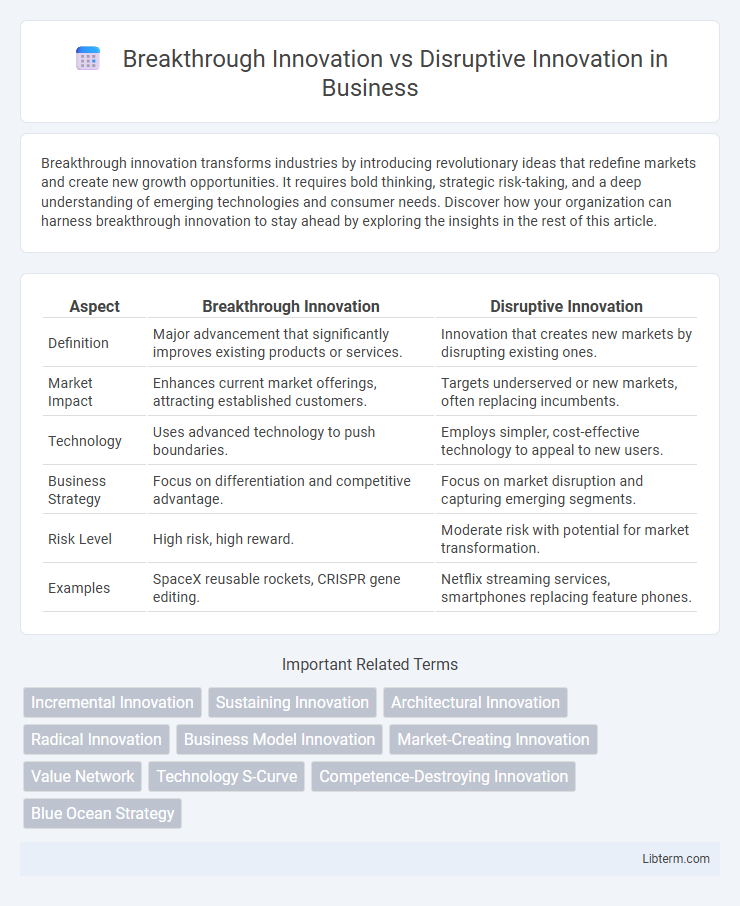Breakthrough innovation transforms industries by introducing revolutionary ideas that redefine markets and create new growth opportunities. It requires bold thinking, strategic risk-taking, and a deep understanding of emerging technologies and consumer needs. Discover how your organization can harness breakthrough innovation to stay ahead by exploring the insights in the rest of this article.
Table of Comparison
| Aspect | Breakthrough Innovation | Disruptive Innovation |
|---|---|---|
| Definition | Major advancement that significantly improves existing products or services. | Innovation that creates new markets by disrupting existing ones. |
| Market Impact | Enhances current market offerings, attracting established customers. | Targets underserved or new markets, often replacing incumbents. |
| Technology | Uses advanced technology to push boundaries. | Employs simpler, cost-effective technology to appeal to new users. |
| Business Strategy | Focus on differentiation and competitive advantage. | Focus on market disruption and capturing emerging segments. |
| Risk Level | High risk, high reward. | Moderate risk with potential for market transformation. |
| Examples | SpaceX reusable rockets, CRISPR gene editing. | Netflix streaming services, smartphones replacing feature phones. |
Understanding Breakthrough Innovation
Breakthrough innovation involves creating fundamentally new products or processes that significantly enhance performance, offering unprecedented value to markets or industries. Unlike disruptive innovation, which typically targets underserved segments and gradually displaces established competitors, breakthrough innovation often leads to groundbreaking advancements that can redefine entire sectors. Businesses prioritizing breakthrough innovation drive exponential growth by investing in cutting-edge research, aiming to solve complex problems with novel solutions.
Defining Disruptive Innovation
Disruptive innovation refers to a process where a smaller company with fewer resources successfully challenges established incumbent businesses by targeting overlooked segments or creating new markets. This type of innovation often starts with simpler, more affordable products or services that gradually improve and eventually displace existing market leaders. The defining characteristic of disruptive innovation is its ability to transform industries by fundamentally altering how value is delivered to customers.
Key Differences: Breakthrough vs. Disruptive Innovation
Breakthrough innovation introduces significant advancements that drastically improve existing products or services, often creating entirely new market opportunities. Disruptive innovation targets underserved or niche markets by offering simpler, more affordable alternatives that eventually reshape or replace established market leaders. The key difference lies in breakthrough innovation enhancing current frameworks, while disruptive innovation fundamentally alters market dynamics through accessible, innovative solutions.
Historical Examples of Breakthrough Innovations
Breakthrough innovations, such as the invention of the steam engine by James Watt and the discovery of penicillin by Alexander Fleming, have historically transformed industries by introducing entirely new capabilities or products. These innovations create significant advancements without necessarily displacing existing markets, unlike disruptive innovations, which redefine market dynamics by introducing simpler, more affordable alternatives. The historical impact of breakthrough innovations can be seen in the Industrial Revolution and the pharmaceutical industry, where they enabled unprecedented growth and development.
Notable Cases of Disruptive Innovations
Notable cases of disruptive innovations include Netflix transforming the entertainment industry by shifting from DVD rentals to streaming services, effectively displacing traditional video rental stores. Airbnb revolutionized the hospitality sector by enabling peer-to-peer lodging, challenging established hotel chains worldwide. Uber altered transportation dynamics by introducing ride-sharing platforms, significantly impacting taxi services and urban mobility.
Impact on Markets and Industries
Breakthrough innovation introduces significant advancements that expand existing markets or create new demand by enhancing product performance or user experience, often complementing current industries. Disruptive innovation reshapes or supplants established markets by offering simpler, more affordable solutions that initially target underserved or new customer segments, ultimately displacing incumbent firms. The impact on industries differs as breakthrough innovations drive evolutionary growth, while disruptive innovations provoke revolutionary change, fundamentally altering market structures and competitive dynamics.
Innovation Process: Breakthrough vs. Disruptive
Breakthrough innovation involves significant advancements within existing markets through novel technologies or methodologies, enhancing product performance or efficiency. Disruptive innovation redefines markets by creating new value networks, often targeting underserved segments and eventually displacing established competitors. The innovation process for breakthrough focuses on incremental research and development within known frameworks, while disruptive innovation requires exploring uncharted market needs and business models.
Strategic Approaches to Fostering Innovation
Strategic approaches to fostering breakthrough innovation prioritize investing in high-risk, high-reward research projects that challenge existing paradigms and leverage emerging technologies to create entirely new markets or products. In contrast, strategies for disruptive innovation focus on identifying underserved market segments and developing simpler, more affordable solutions that eventually redefine industry standards and displace established competitors. Companies often balance these approaches by cultivating cross-functional teams, promoting a culture of experimentation, and maintaining flexible resource allocation to adapt quickly to evolving business environments.
Challenges and Risks Associated with Each Innovation Type
Breakthrough innovation faces challenges such as high R&D costs, uncertain market acceptance, and technical feasibility risks that can delay or derail development. Disruptive innovation involves risks of cannibalizing existing products, resistance from established customers, and difficulty in scaling due to initial inferior performance compared to incumbents. Both innovation types demand careful risk management strategies to mitigate financial losses and market entry barriers.
Future Trends: The Evolving Landscape of Innovation
Future trends in innovation reveal a growing divergence between breakthrough innovation, which leverages advanced technologies like AI and quantum computing to create unprecedented solutions, and disruptive innovation, which reshapes existing markets by introducing more accessible or affordable alternatives. The evolving landscape emphasizes increasing investment in sustainable innovation models and digital transformation to address global challenges such as climate change and resource scarcity. Emerging sectors like clean energy, biotechnology, and smart infrastructure exemplify this dynamic shift, blending breakthrough capabilities with disruptive market strategies to drive economic growth and societal impact.
Breakthrough Innovation Infographic

 libterm.com
libterm.com